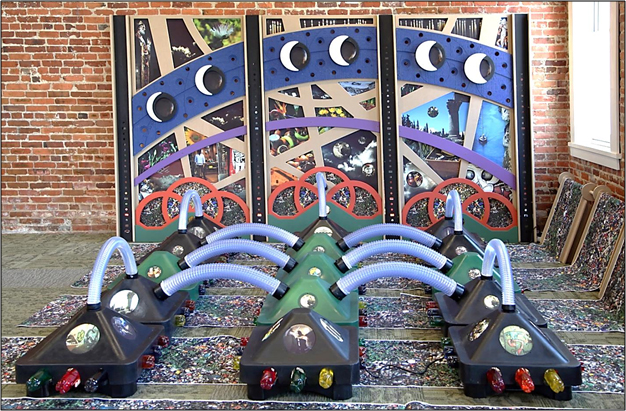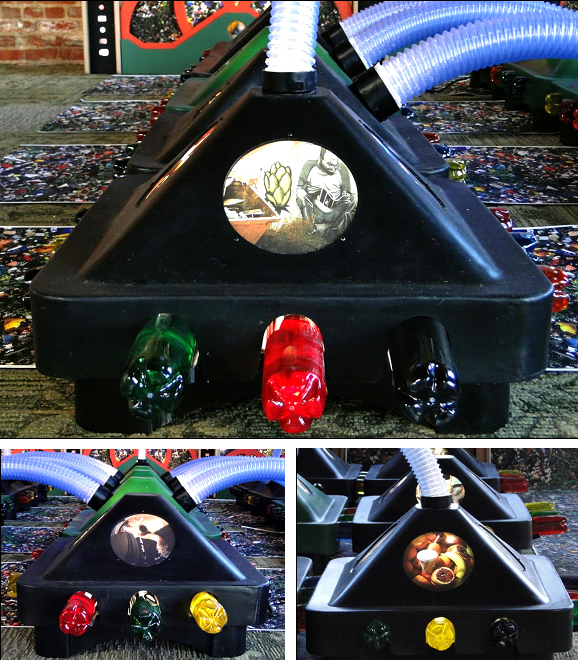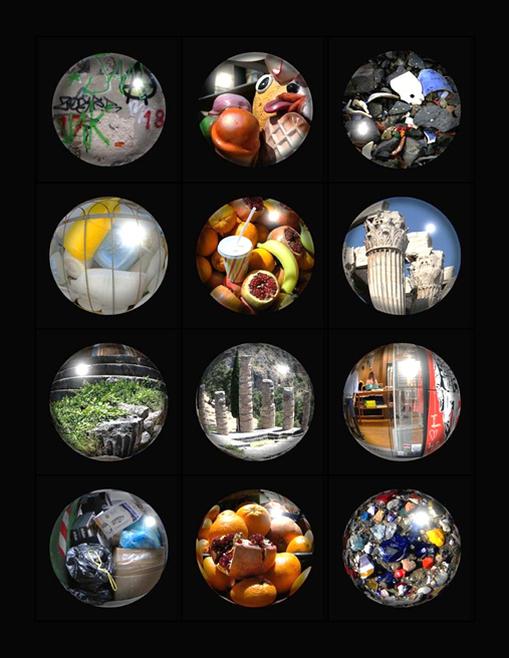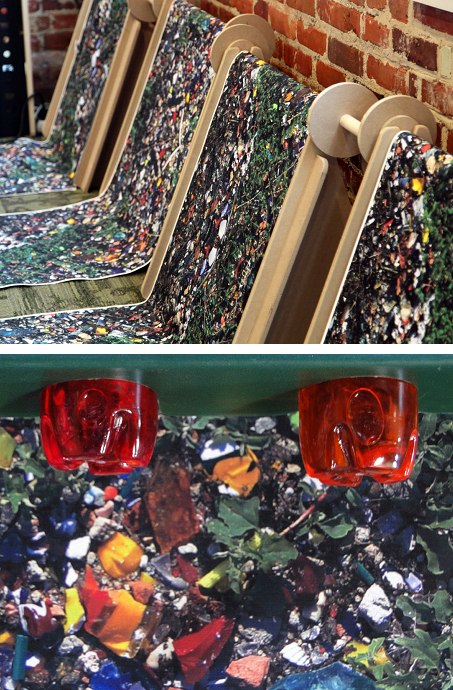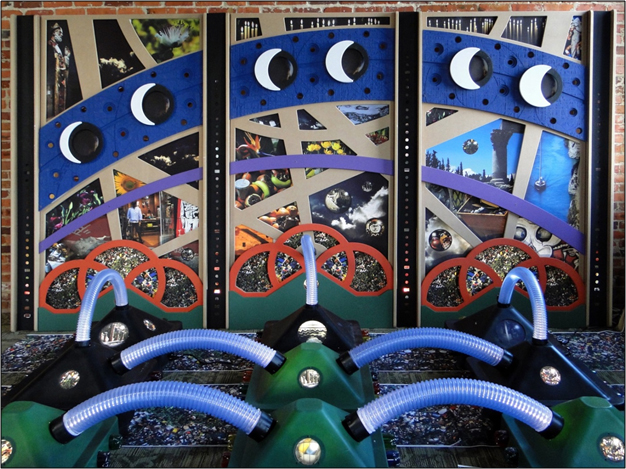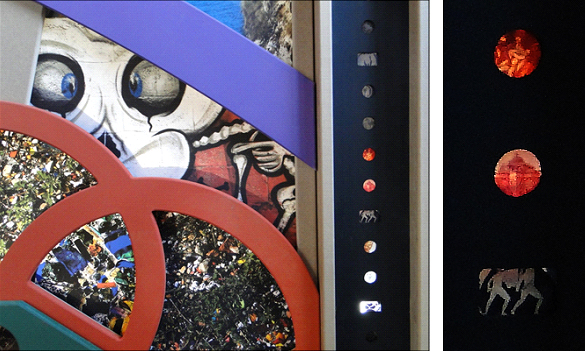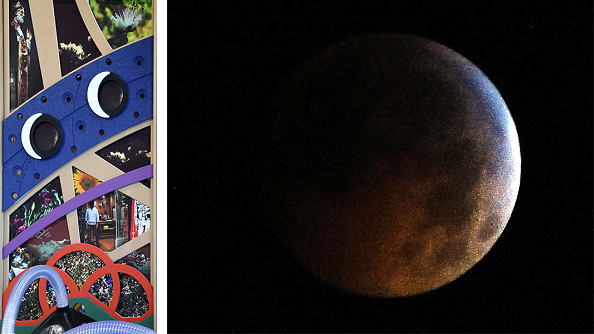Recycled to the Third Power: Sustainability, Cultural Heritage, Preservation
South Regional IDEC Conference
Charleston, South Carolina
2015
Thom Houser
Charleston, South Carolina
2015
Thom Houser
Recycled to the Third Power was a site-specific installation that addressed sustainability, cultural heritage and archeological preservation issues.
This installation was accepted into a juried art competition and was housed in a historic stable (see illustrations 1 and 2). The project measured 14’-3” wide, 14’-9”deep and 7’-0” high. It covered 210 square feet, 400 including circulation.
This installation was accepted into a juried art competition and was housed in a historic stable (see illustrations 1 and 2). The project measured 14’-3” wide, 14’-9”deep and 7’-0” high. It covered 210 square feet, 400 including circulation.
Major components include:
- canvas floor strips bearing images from a landfill
- re-purposed recycling bins lit internally with LED lights and connected with vent hoses
- recycled water bottles
- back-lit wall panels of images gathered from landfills and historic and contemporary urban areas in need of conservation, preservation, or renovation
- back-lit slides from an antiquated art history collection.
Lids from recycling bins were set on inverted bin bases (see illustration 3). These reused recycling bins fitted with industrial tubing invoked comparisons to architectural environments. Openings in the lids featured images of surfaces and places that in some instances were salvaged and in others, defaced (see illustration 4).
|
Illustration 3. Recycled recycling bins. Lids from recycling bins are set on inverted bin bases. Openings have either backlit images within or vent hoses extending from them. Images shown here include graffiti on a wall next to a dumpster in Corinth, Greece (top), a leaking faucet in Rome, Italy (lower left), and a discarded drink cup in Istanbul, Turkey (lower right).
|
|
Illustration 4. Representative images. Photographs were modeled to appear to be floating in air bubbles. Images addressed sustainability, cultural heritages, and preservation issues.
Row 1: Graffiti, Athens, Greece; Fiberglass Cone, Osaka, Japan; Polluted Stream, Dubai, UAE Row 2: Reused Cartons, Cortona, Italy; Produce Stand, Istanbul, Turkey; Temple, Corinth, Greece Row 3: Temple of Apollo, Delphi, Greec (left and center); Shop and Graffiti, Athens, Greece Row 4: Dumpster, Athens, Greece; Produce Stand, Istanbul, Turkey; Landfill, Venice, Italy |
Plastic bottles surrounded and linked the lids. The environmentally unfriendly water bottles were recycled and have been used in several other installation projects. The bottles were filled with rainbow-colored water suggesting environmental hope. The rainbow sequence of bottles, however, was broken randomly to suggest the vulnerability of that hope.
This installation sprang in part from a trip to the Murano Glassworks landfill in Venice where art-glass fragments broke through ground surfaces in brilliant rebirths. The comparison to recycling was obvious. Canvas prints of the landfill were spread from below the windows on one side and travelled across the base of the installation (see illustration 5). The transitory nature of the installation was emphasized by exposing the rollers on which the canvas strips were transported.
This installation sprang in part from a trip to the Murano Glassworks landfill in Venice where art-glass fragments broke through ground surfaces in brilliant rebirths. The comparison to recycling was obvious. Canvas prints of the landfill were spread from below the windows on one side and travelled across the base of the installation (see illustration 5). The transitory nature of the installation was emphasized by exposing the rollers on which the canvas strips were transported.
The back wall of the installation featured a photo-montage wall of back-lit images, recycled art history slides and fiber-board constructions. Images used there suggested multiple ways to salvage, recycle, repurpose and reuse objects (see uncropped photos in illustration 7). Pictures of votive candles along the top of the panels suggested a call for mercy. These were flanked by the remnants of a sacred statue giving a blessing on one side of the panel and a profane ice cream mascot in Osaka, Japan on the other.
|
Illustration 7. Collage photographs. Images suggest multiple ways to salvage, recycle, repurpose and reuse objects. The votive candles along the top of the panels suggest a call for mercy. These are flanked by the remnants of a medieval statue giving a blessing from the collection of the Cloisters in New York and an ice cream mascot in Osaka, Japan.
|
Arbitrarily selected slides from an antiquated art history collection separated the modules of the montage panel. The slides were placed in the Fibonacci sequence moving from the floor upwards, suggesting basic recycling can move our efforts towards a more perfect balance as the sequence moves ever closer to the Golden Mean.
|
Illustration 8. Reused art history slides. Arbitrarily selected slides from an antiquated Art History collection are presented in the Fibonacci sequence moving from the floor upwards, suggesting basic recycling can move our efforts towards a more perfect balance as the sequence moves ever closer to the Golden Mean.
|
This installation was meant to raise questions. Is graffiti a criminal act or is it a form of cultural heritage? How do you distinguish between graffiti as art or as vandalism? How do protecting historic landmarks and artifacts contribute to sustainability of resources and of social heritage?
Although the apparent mood of this installation is festive, there is a dark side: a totally eclipsed Moon (illustration 9) is placed in a swath across the back wall, serving as a warning of the potential future for the Earth. Significantly, many observers of the installation first interpreted the moon images as eyes watching us. (See illustrations 1 and 6 again.)
Although the apparent mood of this installation is festive, there is a dark side: a totally eclipsed Moon (illustration 9) is placed in a swath across the back wall, serving as a warning of the potential future for the Earth. Significantly, many observers of the installation first interpreted the moon images as eyes watching us. (See illustrations 1 and 6 again.)
